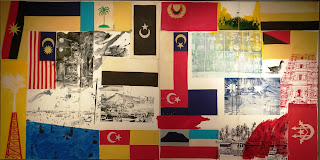12/16 Musings about Negaraku @ NAG

Malaysian artists who work predominantly in sculpture are only a handful; Moving on from conceptual heft and modernist pastimes, there is a fascinating allure to three-dimensional geometric shapes, the raw texture of natural or industrial materials, or forms that interrogate cultural motifs. Rarely is political commentary a subject matter in sculpture, but when it comes about – such as Multhalib Musa’s ‘ Pedra Branca ’ – the effect is oftentimes sublime and better than when presented in a painting. Middle Rocks and the boundary lines are carved onto steel, while structures on the disputed island are painted all-white, in contrast to the present state red-and-white colours. The rectangular base draws attention to the isle, hinting also at the geographical distance of the outlying rock to the Johor coastline, which is three times shorter than the distance to the current claimant. Exhibition snapshot of Multhalib Musa – Pedra Branca (2009)








